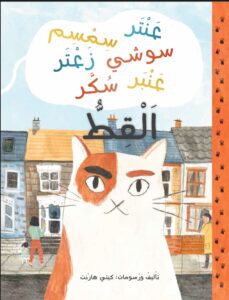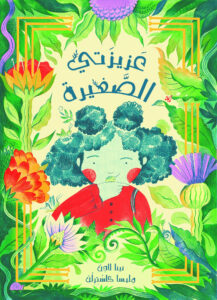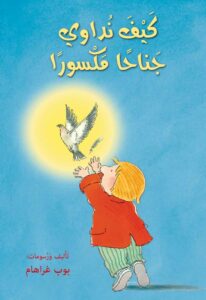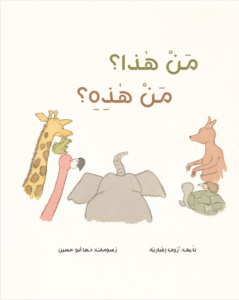Let’s talk...
About the plot: The cat’s names varied in the story. We can follow the events of the story and the cat’s visits to different neighbours, and pay attention to its different names. We can ask our child: Why, in your opinion, did the cat stay in the elderly lady’s house? What did it find there? How did it help her deal with loneliness?
About feelings: We can browse the story with our child and talk about the feelings of the neighbours and the cat. How did they change in the story? And what caused that?
About social relationships: We can ask our child: What changed in the cat’s neighbourhood? How was the relationship between neighbours at the beginning of the story and at the end? We can share with our child things we do with neighbours and relatives on different occasions, such as: eating together, and going on trips.
What activity can we do with the participation of neighbours to enhance the good relationship with them?
Let’s communicate...
With Grandparents: We can spend enjoyable time with grandparents, ask about them and check on them, and maybe share the story with them and ask them: What do you need?
With neighbours: We can initiate an activity with neighbours, such as eating together,or cleaning the neighbourhoodand planting flowers.
We take care of neighbourhood cats: We can provide them with water and food in containers that we can make from used cans.
Let's create...
We can examine the drawings and try to discover the characteristics of each family in the neighbourhood, give them different names, and get to know their diverse cultures as evidenced by their clothes. We can also search for information related to those cultures.
Let's research...
We can search in our home library for stories about cats, such as the story “The Cat Zarif and his Magic Glasses” from the Lantern Library, and others.
Let’s talk...
Fun experiences: We can follow the drawings and accompany the girl and her dog on their journey in nature. We can list the things the girl did, asking our child about the activities they would like to do and the places they would like to visit in their nearby surroundings.
Gratitude and giving thanks: We can talk to our child about gratitude. Together, we list the blessings, starting with ourselves and our social relationships, then moving on to nature and our surroundings.
Let’s create...
Drawing the world around us: We can gather coloured paper and pens, go outside to the garden or street, and “hunt” for colours. We can suggest to our child to draw lines in the shape they choose and select colours that resemble what they see in the world around them. After finishing the drawing, we can hang it in our child’s room.
Let’s initiate...
We communicate and preserve nature: We can think of small actions that can make the world around us a little more beautiful. We can plant some flowers in the neighbourhood, keep nature clean during our walks, plant trees, or take care of a tree in the nearby nature throughout the year.
Let’s enrich our language...
We enrich our vocabulary and introduce our children to the world of animals and their categories—insects, mammals, amphibians, reptiles, birds, and more.
Let’s explore and communicate...
Camping trip in nature: We can explore our country, admire its landscapes, learn about its plants, and listen to its sounds.
Let’s talk...
About the plot: The book is mainly based on drawings. We can encourage our children to “read” the drawings and help them describe them using accurate verbs and vocabulary and make connections between sentences. We can ask them: Why do you think Nabil noticed the wounded bird by himself in the midst of a crowd of people, while no one else noticed it? what did he do?
About feelings: We can talk with our children about the bird’s feelings. We can ask them: How did the bird feel when it hit the glass? How did it feel when no one noticed it?
About sympathy and help: Nabil alone noticed the wounded bird in a crowd of people, while no one else noticed it, and he helped it. We can ask our children: How does Nabil feel about the bird? Why did he help it? How did the bird feel as well? Have they ever seen someone who needs help? How did they feel, and what did they do?
About taking care of the bird: Nabil took care of the bird with the help of his parents until it recovered. We can talk with our children and describe what Nabil has done.
Let’s mimic...
With our children, we can look closely at the moment Nabil released the bird. Together, we can imagine the bird talking and telling the other birds about what Nabil did. We can take on the characters and act them out with our children.
Let’s communicate...
To adopt an animal, we can contact the Animal Welfare Organization. We can explore our favourite animals and find information about them with our kids.
Let’s enrich our language...
With our children, we can track the book with its sequential drawings, and we can enrich and develop the narrative ability of our child by describing the events in a sequence, such as: The father prepared a house for the bird from the cardboard box, and the mother bandaged the broken wing, and then…
Let’s take initiative...
With our children, we can pick a bowl to fill with water and place it on the balcony or on the edge of the window and designate it to water the birds. We should make sure to fill it with water every day. We can also put a bowl of water and leftover food for stray animals on the edge of the road.
 Archie Snuflekins Oliver Valentine Cupcake Tiberius
Archie Snuflekins Oliver Valentine Cupcake Tiberius  Dear Little One
Dear Little One  How to heal a broken wing
How to heal a broken wing  Who is this?
Who is this? 
